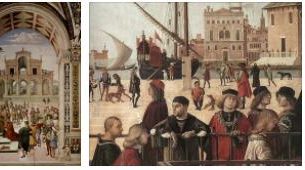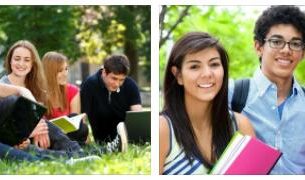Attractions
Purnuskes, Trakai, Kaunas and Grutas
Very close to Vilnius is Purnuskes, the geographic center of Europe. Trakai, the former capital of Lithuania, is located about 25 km from Vilnius on the shore of Lake Galve, which is ideal for boat trips. Pretty wooden houses and a castle from the 14th century characterize the old town. The surrounding area, rich in lakes, is one of the most beautiful parts of Lithuania. The 3000 hectare nature reserve is perfect for long hikes.
Kaunas, the country’s second largest city, is an important industrial and cultural center. In 2022 Kaunas is European Capital of Culture. The museum for depictions of devils invites the fearless to take an extended tour. The memorial to the victims of the German invasion in World War II is more thought-provoking. The three theaters ensure cultural variety. Some castle ruins from the 11th century and the old town hall are also worth seeing.
- Searchforpublicschools: Offers schooling information of Lithuania in each level – compulsory, technical and higher education programs.
About 130 km southwest of Vilnius lies Grutas. Here is the highly original and must-see Gruto Parkas, which features dozens of old communist statues and sculptures. Massive statues of Stalin stand alongside iron statues of Lenin, and there is also a small exhibition displaying items from Lithuania’s communist era.
Vilnius
Founded in 1323 as the capital of the Grand Duchy of Lithuania, Vilnius is surrounded on three sides by forested hills. The river Neris (Vilnya) divides Vilnius in two halves, the city center is on the south bank. In its turbulent history, Vilnius was often destroyed by war or fire, but was always rebuilt. In the beautiful old town, a UNESCO World Heritage Site, you will find a rich mixture of all major European stylistic periods, Gothic alternating with lush Baroque, interspersed with elegant Renaissance or Classical palaces. Pilies gatve (Castle Street) was the main street of medieval Vilnius and is located in the heart of the Old Town. Old city palaces and merchant houses stretch along the street. ThatHotel Narutis was built in the 16th century and has remained unchanged, only the interiors have been adapted to the 20th century.
In the heart of the city is the beautiful Gediminas Square, home to the Cathedral, built by the first Christian convert of Lithuania, Mindaugas the Great. Of particular interest is the early Baroque St. Casimir’s Chapel (1623-1636), beneath which is a mausoleum containing the remains of the Lithuanian Grand Duke and patron saint Casimir Jagiellon. Also worth seeing is the church of St. Anne, which was built in the middle of the 16th century in a massive Gothic style. The original interior was destroyed by fire. theChurch of St. Michael is a classic Renaissance building and was built between 1594 and 1625. In the church there is a small architecture museum worth seeing. The Church of the Holy Spirit was built at the end of the 14th century. In 1501 the church, which had been repeatedly destroyed and rebuilt, was given to the Dominican order, who built a monastery nearby. The current façade dates from the 18th century after the interiors had been destroyed by fire and had to be restored.
Renaissance influences can also be found in some courtyards of the beautiful old universityof Vilnius (founded in 1579 and thus one of the oldest universities in Europe). A stunning panoramic view of Vilnius can be seen from the restored western tower of the perched Gediminas Castle.
Vilnius was European Capital of Culture in 2009.
Museums in Vilnius
Museums in Vilnius include the Lithuanian National Museum, which offers an excellent insight into the history of Lithuania from the Stone Age to 1940. The rather depressing KGB Museum is housed in the former KGB building. Here you can see the original prison cells and execution rooms where thousands of Lithuanians were held captive and interrogated before being killed or sent to Siberia. The stone exterior walls of the museum are engraved with the names of those who died in this building.
The MO Museum has been showing Lithuanian art since 1960, which was created during the Cold War and was not accessible to the world public at that time.
Shopping
Overview
amber, linen fabrics and handicrafts. Shop opening hours: Mon-Fri 08.00-20.00 (grocery stores).
Nightlife
Introduction
There is a wide range of restaurants, cafes, bars and nightclubs in Vilnius. Opera performances and ballet evenings can be enjoyed at the Vienuolio Theater. The Lithuanian National Opera offers a varied program (Internet: www.opera.lt). The productions in the Januimo Theater are particularly well-known. Restaurants with live music, discotheques and nightclubs with variety programs also offer evening entertainment in the other major cities. There are cinemas in all cities, Kaunas has a music theater. Marionette plays for children are offered in Vilnius and Kaunas.
Culinary
Overview
Specialties include skilandis (meat snack), salti barsciai (soup served cold), bulviniai blynai (potato pancakes), vedarai (potato sausage) and cepelinai (grated potatoes stuffed with minced meat). Stewed goose stuffed with apples and plums is another Baltic specialty. Smoked eel is served on the Baltic coast. Midus, the famous Lithuanian honey drink with a light alcohol content, is a must-try.
Accommodation
Hotels
In Vilnius there are numerous larger hotels with very good comfort. Outside of Vilnius there is a good selection of larger hotels and smaller guesthouses. Advance booking is strongly recommended. The big hotels in Kaunas are in the city center, in Klaipeda there are also some bigger hotels available. Good accommodation options in Palanga and on the Curonian Spit are offered by boarding houses and holiday hotels. Further information can be obtained from the Baltic Tourist Board (see addresses) and the Lithuanian Hotel Association, Fabijonisiu st. 99, LT-07101 Vilnius (Tel: (05) 26 25 241. Internet: www.lithuanianhotels.com). Hotel Classification: Hotels are classified into the Hotelstars Union star categories from one to five stars.
Camping
There are few official campsites, but they are located in the most beautiful parts of the country, such as Palanga (Baltic Coast) and Trakai (Lake District), or close to the largest cities, including three in and around Vilnius. Camping is prohibited on the Curonian Spit. On almost all lakes and river banks, even in the national parks, you can pitch your tent at designated spots for a small fee, but there are hardly any service facilities. If you park your caravan in a nature reserve, you have to expect high fees.
Other accommodation options
At the moment there are about 8 youth hostels in Lithuania. Information is available from Lithuanian Hostels Association, Aušros Vartu 20-15a, LT-02100 Vilnius (tel: 65 65 65 71. Internet: http://www.lha.lt/).
Culture
Religion
Predominantly Roman Catholic (79%); Protestant, Jewish and Muslim minorities and members of the Russian Orthodox faith.
Social Rules of Conduct
Manners: When greeting someone shakes hands. The usual forms of politeness also apply here. Lithuanians are very proud of their culture and history, which visitors should respect. Tipping: Service charges are included in bills. However, an extra tip of 5-10% is customary. Taxi drivers also receive a tip. Smoking: Smoking is prohibited in public facilities such as restaurants and on public transport. Airports and train stations as well as long-distance trains have smoking zones.
Climate
Best travel time
Temperate climate, transition zone between continental and maritime climate. Generally rather changeable. Warm summers, spring and autumn are relatively mild. Cold winters, often with heavy snowfall.
Country data
Phone prefix
+370
Area (sq km)
65300
Population
2,722,289 (Source: homosociety)
Population density (per square km)
44
Population statistics year
2020
Member of the EU
yes
Main emergency number
112



